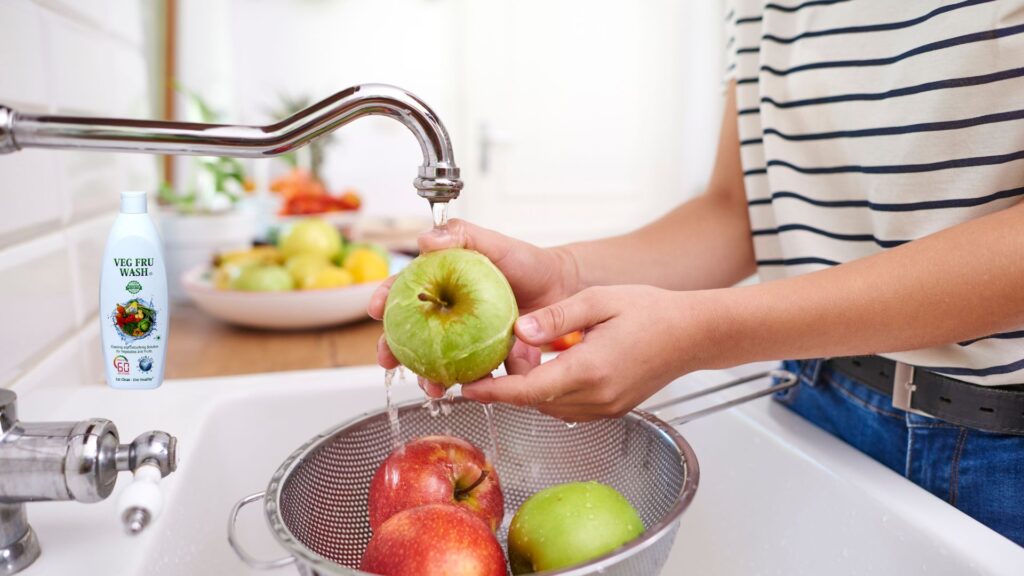
Incorporating fruits and vegetables into your diet is a cornerstone of healthy living. However, the journey from farm to table can expose your produce to various contaminants. A dedicated fruit and vegetable wash can significantly enhance the cleanliness and safety of your produce. This blog will explore the reasons why using a fruit and vegetable wash is crucial, the benefits it brings, and the step-by-step process for effectively washing your produce.
The Importance of a Fruit and Vegetable Wash
- Combat Pesticide Residues: Pesticides are widely used in agriculture to protect crops from pests and diseases. However, these chemicals can leave residues on the surface of fruits and vegetables. A specialized fruit and vegetable wash is formulated to break down and remove these residues more effectively than water alone.
- Reduce Bacterial Contamination: Fruits and vegetables can be exposed to harmful bacteria and pathogens such as E. coli, Salmonella, and Listeria during various stages of production and distribution. These pathogens can cause serious health issues if ingested. Using a fruit and vegetable wash can help eliminate these harmful microorganisms, ensuring your produce is safe to consume.
- Remove Wax and Soil: Many types of produce are coated with wax to preserve freshness and improve appearance. This wax can trap dirt and bacteria. A fruit and vegetable wash can dissolve the wax, making it easier to wash away dirt and contaminants.
Benefits of Using a Fruit and Vegetable Wash
- Enhanced Cleaning Efficiency: Compared to water alone, a dedicated wash is designed to penetrate and remove a broader range of contaminants, including pesticides, bacteria, wax, and dirt.
- Better Taste and Texture: Clean produce not only tastes better but also has a more appealing texture. By removing contaminants, a fruit and vegetable wash helps you fully enjoy the natural flavors of your produce.
- Health Assurance: Knowing that your fruits and vegetables are thoroughly cleaned provides peace of mind. You can feel confident that you are minimizing the risk of exposure to harmful substances and providing safe, nutritious food for your family.
How to Use a Fruit and Vegetable Wash Effectively
- Select the Right Product: Choose a wash specifically designed for cleaning fruits and vegetables. Look for products that are natural, non-toxic, and free from harmful chemicals.
- Follow Usage Instructions: Each product may have specific instructions for use. Typically, you will need to dilute the wash in water or spray it directly onto the produce. Follow the recommended guidelines for the best results.
- Soak and Scrub: For produce with tough skins, such as apples, potatoes, and carrots, soak them in the wash solution for a few minutes and then scrub with a vegetable brush. This helps remove stubborn dirt and contaminants.
- Rinse Thoroughly: After using the wash, rinse the produce thoroughly under cold running water. This helps remove any remaining residues from the wash itself.
- Dry Properly: After washing and rinsing, dry your produce with a clean cloth or paper towel. This step helps remove any lingering bacteria and reduces moisture that can promote bacterial growth during storage.
Specific Tips for Different Types of Produce
- Leafy Greens: Separate the leaves and rinse them individually after soaking in the wash solution. This ensures that all parts of the greens are thoroughly cleaned.
- Berries and Soft Fruits: Place delicate berries in a colander and rinse gently after soaking in the wash solution. Be careful not to soak them for too long, as they can absorb water and become mushy.
- Root Vegetables: Scrub root vegetables like beets, carrots, and potatoes with a brush after soaking. This helps remove embedded dirt and contaminants effectively.
- Cruciferous Vegetables: Soak vegetables like broccoli and cauliflower in the wash solution to remove dirt and insects hiding in the crevices. Rinse thoroughly afterward.
- Herbs: Fresh herbs can also carry dirt and bacteria. Rinse them under cold running water after soaking in the wash solution and pat them dry with a clean cloth or paper towel.
Additional Considerations
- Organic Produce: Even organic fruits and vegetables can benefit from a thorough wash to remove dirt, bacteria, and any residual organic pesticides.
- Homemade Wash Solutions: If you prefer a DIY approach, you can create your own wash solution using natural ingredients such as vinegar, lemon juice, or baking soda. However, be sure to rinse thoroughly to remove any remaining solution.
- Frequency of Washing: Make it a habit to wash all fruits and vegetables before consumption, regardless of whether they will be eaten raw or cooked. This ensures maximum cleanliness and safety.
Conclusion
Using a dedicated fruit and vegetable wash is a vital step in ensuring the safety and quality of your produce. By effectively removing pesticides, bacteria, wax, and dirt, you can enjoy cleaner, healthier, and more delicious fruits and vegetables. Make it a part of your routine to wash all your produce thoroughly, and enjoy the peace of mind that comes with knowing your food is safe and nutritious.


